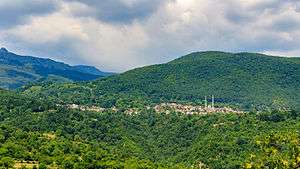Trebište

Trebište, Trebishte, or Trebišta (Macedonian: Требиште) (the pronunciation used by the local population is Trebišča) is a village in the Republic of Macedonia in Mavrovo and Rostuša Municipality, situated in the Dolna Reka district, on the eastern slopes of Dešat, above the gorge of Radika.
History
In 1426 Gjon Kastrioti from Albania and his three sons (one of them was Skanderbeg) donated the right to the proceeds from taxes collected from the villages Rostuša and Trebište and from the church of Saint Mary, which was in one of them, to the Hilandar.[1] In an Ottoman defter from 1467, the village of Trabšta is mentioned together with Rostuša as part of the Reka vilayet. According to this document, the village then had 15 Christian Orthodox families. In 1519, 55 Christian Orthodox families were recorded in the village, while in 1583, the village had 41 Christian Orthodox families and 5 Muslim families.[2]
In the 19th century, Trebište was a mixed Bulgarian (Christian)-Pomak (Muslim) village in the district of Dolna Reka, then part of the Ottoman Empire. In the book “Ethnographie des Vilayets d'Adrianople, de Monastir et de Salonique”, published in Constantinople in 1878, that reflects the statistics of the male population in 1873, Trebišta was noted as a village with 150 households, of which 255 were Pomaks and 144 were Bulgarians.[3]
According to Vasil Kanchov’s statistics, in 1900, Trebišta had 192 Christian Bulgarian inhabitants and 640 Muslim Bulgarians.[4]
The whole Christian population of the village was under the supremacy of the Bulgarian Exarchate. According to the evidences of Dimitar Mishev, the secretary of the Exarchate, in 1905, in Trebište there were 338 Bulgarians and there was a Bulgarian school that functioned in the village.[5]
There were 600 Islamised Slavs and 300 Christians in 1925.[2]
In 1981, the village had 1,037 Muslims, 51 Macedonians and four Albanians.[2]
According to the 2002 census, the village has 765 inhabitants.[6]
References
- ↑ Slijepčević, Đoko M. (1983). Srpsko-arbanaški odnosi kroz vekove sa posebnim osvrtom na novije vreme (in Serbian). Himelstir. p. 45. Retrieved 7 July 2011.
Заједно са синовима Константином, Репошем и Ђурђем приложио је Иван Кастриот манастиру Хиландару село Радосуше са црквом св. Богородице и село Требиште....(Together with his sons Konstantin, Repoš and Đurađ, Ivan Kastriot donated village Radosuše with church of saint Mary and village Trebište to the monastery Hilandar...
- 1 2 3 Dve povelje u Hilandaru o Ivanu Kastriotu i sinovima, Dušan Sindik
- ↑ „Македония и Одринско. Статистика на населението от 1873 г.“ Македонски научен институт, София, 1995. стр. 174-175.
- ↑ Кънчов, Васил. „Македония. Етнография и статистика“. София, 1900. стр.263.
- ↑ Brancoff, D.M. "La Macédoine et sa Population Chrétienne". Paris, 1905, р.184-185.
- ↑ Министерство за Локална Самоуправа. База на општински урбанистички планови
Coordinates: 41°37′N 20°35′E / 41.617°N 20.583°E